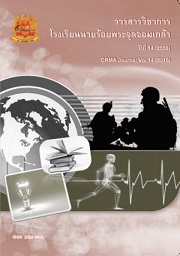Analysis of Blast Pressure and Behavior of RC Structures under Blast Loading
Main Article Content
Abstract
This article reviews approaches to determine blast pressure-time histories by finding related parameters from the chart given in UFC 3-340-02. The related parameters such as blast peak pressure, arrival time, duration time, impulse and velocity of wavefront can be determined from the chart by specifying blast scaled distance. A CFD (Computational Fluid Dynamics) analysis is another approach used to analyze blast pressure-time histories on structures with complex shape and/or surrounded by other structures. It is possible to simulate phenomenon of blast waves such as reflection, constructive superposition and refraction which are normally observed in real incidences. This article also discusses about Single Degree of Freedom (SDOF) and Finite Element Method (FEM) as analysis approaches used to investigate behavior of blast loaded structures. An FEM simulation employed to analyze the equivalent weight of bare charge TNT used in the bomb blast incidence at Erawan shrine, Ratchaprasong on August 17, 2015 is presented in this article as a case study.
Article Details
Copyright of all articles published is owned by CRMA Journal.
References
กันต์ไชย ธนาพรรวีกิตติ์ และสมนึก ตั้งเติมสิริกุล, 2558. การใช้เทคนิค Forensic Engineering ในการวิเคราะห์เหตุการณ์ระเบิดที่ราชประสงค์. วารสารคอนกรีต ฉบับที่ 24 :1-10.
U.S. Department of Defense, 2008. Structures to resist the effects of accidental explosions, UFC 3-340-02.
Baker, W.E., 1973. Explosions in Air. Austin : University of Texas Press.
U.S. Department of Army.TM5-855-1, 1986. Fundamental of protective design for conventional weapons effects.
FEMA 427, 2003. Primer for Design of Commercial Buildings to Mitigate Terrorist Attacks.
Karamcheti, K., 1980. Principles of ideal-fluid aerodynamics. Florida : Krieger publishing.
Rose, T. A., 2001. An approach to the evaluation of blast loads on finite and semi infinite structure. Ph.D. Thesis, Cranfield University.
Century Dynamics, 2005. AUTODYN theory manual revision 4.3
J.O. Hallquist, 2015. LS-DYNA Keyword User’s Manual Version R8.0, Livermore Software and Technology Corporation, Livermore CA.
Forth, S., 2012. ProSAir User Guide. Applied Mathematics and Scientific Computing, Cranfield University.
Riisgaard B, Ngo T, Mendis P, Georgakis C, Stang H., 2007. Dynamic Increase Factors for High Performance Concrete in Compression using Split Hopkinson Pressure Bar. In Fracture Mechanics of Concrete and Concrete Structures.
Crawford, J. E. and Malvar, L. J., 2006. User's and theoretical manual for K&C concrete model, TR-06-19.1, Karagozian & Case.
Malvar, L. J., 1998. Review of static and dynamic properties of steel reinforcing bars. ACI Materials Journal, Vol. 95, No. 5 : 609-616.
Flathau, W. J., 1971. Dynamic tests of large reinforcing bar splices, Technical Report N-71-2, U.S. Army Engineer Waterways Experiment Station.
Smith, P. D. and Mays, G. C., 1995. Blast effects on buildings. London : Thomas Telford.
ASTV manager online (News on August 18, 2015)
ภาพจากมูลนิธิท่านท้าวมหาพรหม.


